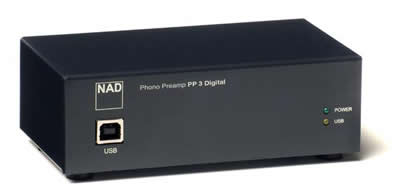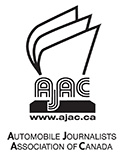|

NAD Phono Preamp Revives TurntablesBy Jim Bray It appears the reports of vinyl records' demise may have been premature. Okay, chances are you don't find a lot of vinyl on your local audio/video software store shelves, and may not have seen it for years, but some audiophiles have never abandoned the format and it now appears the old black magic of 33 1/3 rpm records may even be making a comeback of a kind. All of which makes NAD's $199 PP-3 Digital Phono Preamplifier a very timely device. It not only lets you play your vinyl even on modern audio systems, it lets you capture them to a computer and back them up onto CD, MP3, portable music player or whatever – effectively making your vinyl library portable. The PP-3 is a small, black box that, at 5.3 inches long by 1.38 inches high by 2.75 inches deep, is tiny enough to fit onto most stereo stands (it fits beautifully on mine, next to the PS3 ironically enough). This is great because I've been using some fine Rotel equipment for the past several years that, while wonderful, follows the current trend of not offering a phono preamp. And why would it? The world has mostly forgotten that such things ever existed. Unfortunately, a phono preamp is necessary to make a turntable's output compatible with a "normal" preamp, receiver or integrated amp. Fortunately, thanks to the PP-3, I can now hook my old top-of-the-line direct drive Sansui turntable right into my state-of-the-art Rotel, via the PP-3, and play records again. I love it! Why would I want to do that, when digital audio is said to be so much better than analog? Well, think of "garbage in, garbage out" – in that a well-recorded and pressed album can sound as good or better than a poorly recorded and mastered digital version. I've heard it over and over, especially with older CD's that, compared to their vinyl versions, sound thin or muddy or compressed. Maybe it's because computers have no soul, but a good vinyl record can have a kind of warm presence that digital formats may not. I thought for a long time that the die hard analog apologists were just fuddy-duddies, but either my ears have grown more discerning over the years or I've become just another fuddy-duddy. Whatever the reason, I do love a good record. Listening to my old platters again has been a marvelous experience, and playing them back on a high quality modern audio system like my Rotel stuff really brings them to life. Sometimes, I hear nuance never heard before on an album I played hundreds of times decades ago. Well, the albums that aren't so well-used you can see through the grooves… I had almost forgotten that particular disadvantage of vinyl: it deteriorates with playing, as tiny amounts of the evil oil product from which they're made are scraped away by the turntable's stylus. That brings up another reason to burn your vinyl: archiving. I'm still not convinced that a digital file or CD made from a vinyl record is as good as the original album, though some CD's I've made sound excellent, and very dynamic. But if nothing else, it gives you a "safety" copy of the record, as well as making your records portable and compatible with more of today's audio equipment. It also means you may not have to buy your library over and over again. NAD says the PP-3 builds on the design of its predecessor, the award-winning PP-2 MM/MC Phono Preamp, by adding a high-quality analog-to-digital converter, a USB interface, and the CD-R VinylStudio Lite software that lets you copy LP's to a PC directly in .wav or .mp3 formats. And it works as advertised. The VinylStudio software records your LPs and tapes and you can use it to look up track listings over the Internet. There's even some capability to remove clicks, hiss, hum and the like. The light version is okay, but if you really want to tweak and clean and otherwise "fix" the audio files, you should upgrade to the full version or use another app. That's what I did, using VinylStudio to record but opting for Magix Audio Cleaning Lab to do the "undirtying" deed – mostly because I know it better. The fact that the PP-3 preamp allows the lion's share of turntables to be played on today's systems is, in my opinion, one of the most important features of this preamp. Thanks to it, turntables that have been stored away in closets or crawlspaces for years can now find a home on the top shelf of a modern surround sound audio system. I'm one of them, though it's tough finding room on the top shelf these days! Maybe I should start a support group of "former digital addicts". The NAD seems well built, the connections are solid and the unit works well. The connection from turntable to preamp/receiver uses garden variety RCA jacks, which are available just about everywhere, and there's even a grounding terminal. This is about the third turntable-to-PC product I've reviewed, one of which was a modern turntable that had USB and its own phono preamp built. I've liked each of these products for different reasons, especially the USB turntable. But despite that turntable's pluses, it's still a lower end model than my ancient Sansui (which still works fine after all those years in the crawl space) and, like a comfy pair of jeans, I have a soft spot for it and would rather use it again. And now I can. One thing I've learned reviewing this type of technology is not to tweak the recorded sound files unless they sound really awful, because if you aren't careful you can throw out some of the music baby with the pops and clicks bath water. One way to experiment before committing your digital files to optical disc is to test them on a rewriteable disc first. This works fine. Oh, yeah, I nearly forgot: the PP-3 also has an extra line input so you can hook in other analog sources like a tape deck or radio tuner, so you can convert their output to digital as well. Guess that means it's back into the crawl space to see where I left that old AKAI reel-to-reel… The NAD PP-3 is obviously not a product for everybody, but it's a darn nice way to build a bridge to the 20th century for those who want to keep their turntables around – and maybe it'll help keep some round and flat plastic discs out of the landfills. June 1, 2009 Reader's comment: STATE-OF-THE-ART You mentioned "my old top-of-the-line direct drive Sansui turntable". Aren't "top-of-the-line" turntables belt-driven turntables? Direct-drive turntables have the motor "directly" connected to the turntable platter. That motor vibration (though small) is a "mechanical" connection and starts at the armature of the motor; that small motor sound goes directly to the spindle, which is connected directly (pressure fitted) at/to the vinyl record, the sound moves from the "inside" of the record toward the "outside" of the record increasing (amplifying) the sound (vibration) still from the motor. The stylus (needle) picks up this vibration and again amplifies that sound THROUGH THE AMPLIFIER, now mixing it in with the recorded information on the vinyl and sending that information through the speakers. Belt-driven turntables, on the other hand, are NOT directly connected to the platter and therefore alleviates the sound of the motor getting to the stylus (cartridge) thereby reducing or removing the sound of the motor. Belt-driven turntables would therefore be "state-of-the-art". Copyright 2009 Jim Bray Jim Bray's columns are available through the TechnoFile Syndicate. We welcome your comments! |
|
|||

